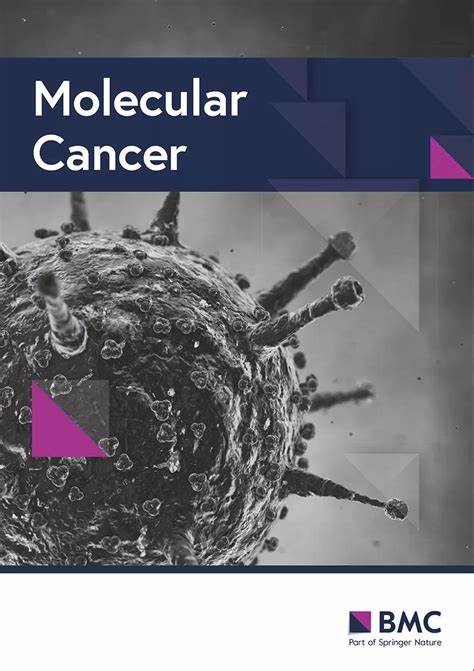单细胞遗传学和转录组学联合分析揭示了人类神经母细胞瘤的恶性前 SCP 样亚克隆
IF 27.7
1区 医学
Q1 BIOCHEMISTRY & MOLECULAR BIOLOGY
引用次数: 0
摘要
神经母细胞瘤(NB)是一种异质性胚胎性恶性肿瘤,也是婴儿期最致命的肿瘤。它是一种复杂的疾病,可导致不同的临床结果。有些患儿的肿瘤会自然消退。另一些则对现有的治疗方法反应良好。但是,对于约占所有患者 40% 的高危人群来说,尽管基础和临床研究人员通力合作,但预后仍然不容乐观。尽管其确切的细胞起源仍存在争议,但人们认为 NB 起源于神经嵴细胞系,包括多能的许旺细胞前体(SCPs),它们分化成交感肾上腺细胞状态,最终产生嗜铬细胞和交感母细胞。为了研究神经母细胞瘤细胞状态的克隆发展,我们使用单细胞多组学技术对人类肿瘤样本进行了单倍型特异性分析,包括对分选的单细胞进行DNA/RNA联合测序(DNTR-seq)。我们还利用免疫荧光染色和荧光原位杂交(FISH)对样本进行了评估。除了肾上腺素能肿瘤细胞外,我们还发现了非整倍体 SCP 样细胞亚群,其特点是克隆扩增、全染色体 17 增殖以及增殖、凋亡和非免疫调节表型的表达程序。非整倍体恶性前SCP样细胞代表了NB的一种新特征。遗传学证据和肿瘤系统发育表明,这些克隆和恶性肾上腺素能细胞群起源于易发生非整倍体的移行神经嵴细胞或SCP细胞,然后才进入交感肾上腺细胞状态。我们的发现扩大了 NB 细胞状态的表型谱。考虑到 SCP 在发育过程中的多潜能性,我们认为胎儿 SCP 的转化可能代表了以 17 号染色体畸变为特征要素的 NB 肿瘤发生的一种可能机制。本文章由计算机程序翻译,如有差异,请以英文原文为准。
Joint single-cell genetic and transcriptomic analysis reveal pre-malignant SCP-like subclones in human neuroblastoma
Neuroblastoma (NB) is a heterogeneous embryonal malignancy and the deadliest tumor of infancy. It is a complex disease that can result in diverse clinical outcomes. In some children, tumors regress spontaneously. Others respond well to existing treatments. But for the high-risk group, which constitutes approximately 40% of all patients, the prognosis remains dire despite collaborative efforts in basic and clinical research. While its exact cellular origin is still under debate, NB is assumed to arise from the neural crest cell lineage including multipotent Schwann cell precursors (SCPs), which differentiate into sympatho-adrenal cell states eventually producing chromaffin cells and sympathoblasts. To investigate clonal development of neuroblastoma cell states, we performed haplotype-specific analysis of human tumor samples using single-cell multi-omics, including joint DNA/RNA sequencing of sorted single cells (DNTR-seq). Samples were also assessed using immunofluorescence stainings and fluorescence in-situ hybridization (FISH). Beyond adrenergic tumor cells, we identify subpopulations of aneuploid SCP-like cells, characterized by clonal expansion, whole-chromosome 17 gains, as well as expression programs of proliferation, apoptosis, and a non-immunomodulatory phenotype. Aneuploid pre-malignant SCP-like cells represent a novel feature of NB. Genetic evidence and tumor phylogeny suggest that these clones and malignant adrenergic populations originate from aneuploidy-prone cells of migrating neural crest or SCP origin, before lineage commitment to sympatho-adrenal cell states. Our findings expand the phenotypic spectrum of NB cell states. Considering the multipotency of SCPs in development, we suggest that the transformation of fetal SCPs may represent one possible mechanism of tumor initiation in NB with chromosome 17 aberrations as a characteristic element.
求助全文
通过发布文献求助,成功后即可免费获取论文全文。
去求助
来源期刊

Molecular Cancer
医学-生化与分子生物学
CiteScore
54.90
自引率
2.70%
发文量
224
审稿时长
2 months
期刊介绍:
Molecular Cancer is a platform that encourages the exchange of ideas and discoveries in the field of cancer research, particularly focusing on the molecular aspects. Our goal is to facilitate discussions and provide insights into various areas of cancer and related biomedical science. We welcome articles from basic, translational, and clinical research that contribute to the advancement of understanding, prevention, diagnosis, and treatment of cancer.
The scope of topics covered in Molecular Cancer is diverse and inclusive. These include, but are not limited to, cell and tumor biology, angiogenesis, utilizing animal models, understanding metastasis, exploring cancer antigens and the immune response, investigating cellular signaling and molecular biology, examining epidemiology, genetic and molecular profiling of cancer, identifying molecular targets, studying cancer stem cells, exploring DNA damage and repair mechanisms, analyzing cell cycle regulation, investigating apoptosis, exploring molecular virology, and evaluating vaccine and antibody-based cancer therapies.
Molecular Cancer serves as an important platform for sharing exciting discoveries in cancer-related research. It offers an unparalleled opportunity to communicate information to both specialists and the general public. The online presence of Molecular Cancer enables immediate publication of accepted articles and facilitates the presentation of large datasets and supplementary information. This ensures that new research is efficiently and rapidly disseminated to the scientific community.
 求助内容:
求助内容: 应助结果提醒方式:
应助结果提醒方式:


